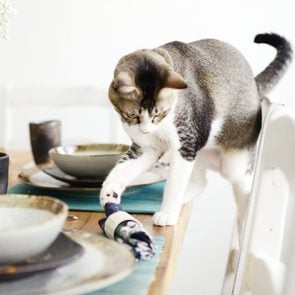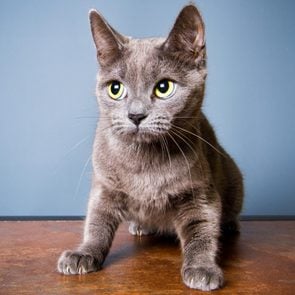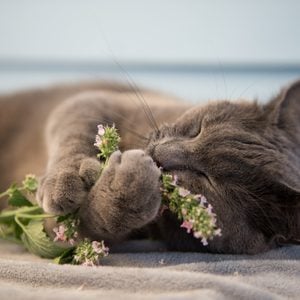How to Decode Your Cat’s Body Language, According to Experts
Updated: Mar. 26, 2024
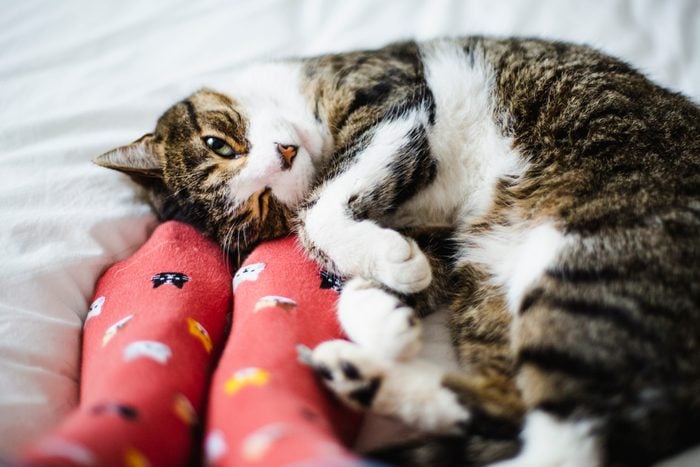
Observing your cat's body language can tell you all sorts of things about its mood, needs, and even feelings toward you!
Sometimes it can feel like you have no idea what your cat is thinking or feeling. Maybe it’s making strange meows or loafing and you aren’t sure if it’s happy, angry, or jealous or perhaps it will show you its adorable belly only to swat your hands away the second you go in for a cuddle. Maybe it’s rubbing against you, and you’re not sure what it wants. Figuring out the reasons behind cat behavior can certainly be a conundrum.
Fortunately, you can decipher quite a bit by simply observing a cat’s body language. Below, we’ve outlined some of the most common cat positions and movements to be on the lookout for, such as slow blinking, hunching its back, and lying down to display its tummy. We’ve even included a cat body-language chart for quick reference.
While you’re at it, also find out why scruffing a cat is a big no-no!
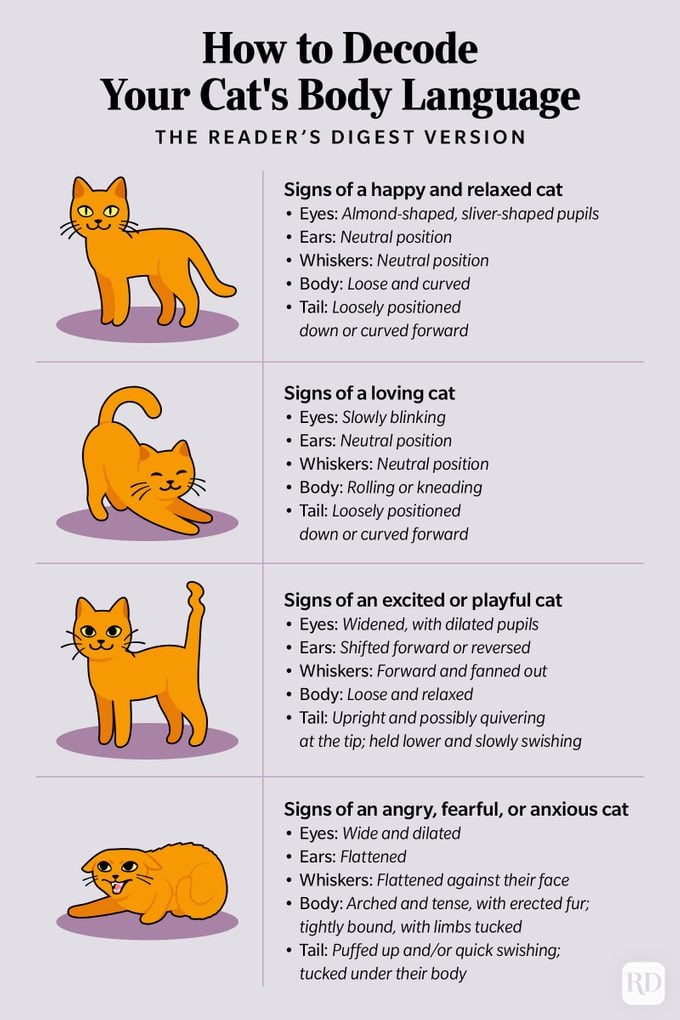
Happy and relaxed
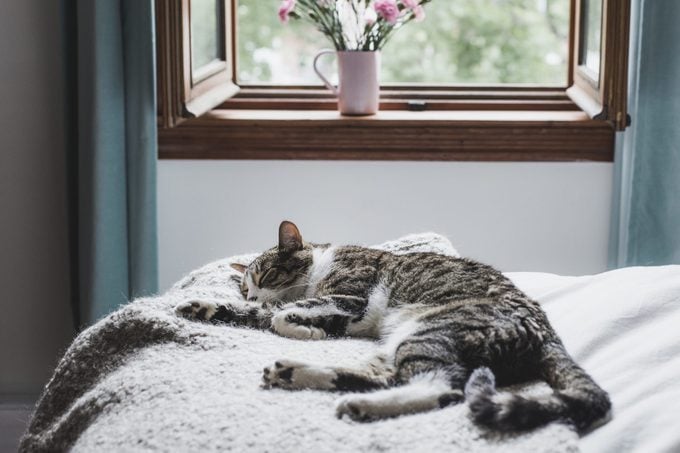
Generally speaking, happy and relaxed felines have cat body language that’s loose and gently curved. If you were to pick them up or pet them, they’d feel soft, heavy, and relaxed rather than rigid or tense.
“A happy and relaxed cat usually has its legs extended or stretched out away from its body, and its tail may be extended out or loosely wrapped around the body when it’s resting,” says Sam Nigbur-Mays, a behavioral sciences team counselor at the American Society for the Prevention of Cruelty to Animals (ASPCA).
When on the move, a relaxed cat’s tail will likely be loosely down or held up and curved forward. Nigbur-Mays adds that happy and relaxed cats also usually hold their ears and whiskers in a neutral position, and their eyes are generally almond-shaped, with thinner, sliver-shaped pupils.
“A relaxed cat may roll onto its back and expose its stomach, but unlike dogs, this is simply an indication that it feels safe—it is not an invitation to pet its belly!”
Telltale signs of a happy and relaxed cat
- Eyes: Almond-shaped, sliver-shaped pupils
- Ears: Neutral position
- Whiskers: Neutral position
- Body: Loose and curved
- Tail: Loosely positioned down or curved forward
Loving
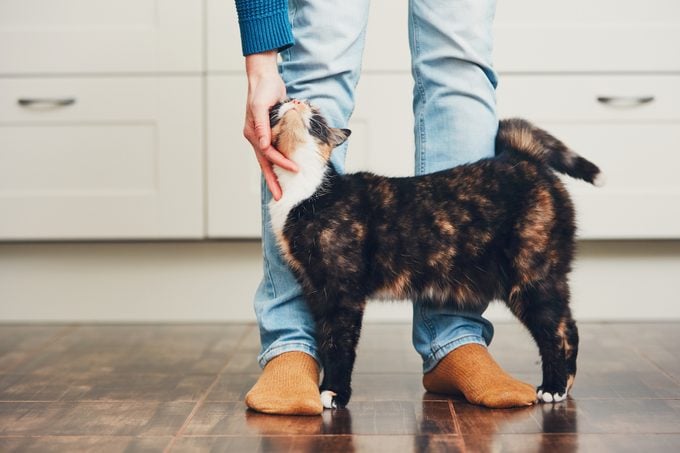
Cats have a reputation for being aloof and independent, but they are also equipped to love their humans fiercely. Though they often do so with cat body language that’s easy to miss! In addition to exhibiting the happy and relaxed behavior below, some common ways cats show love and affection include bunting (rubbing against furniture or walls) and even head-butting you. When they do these things, they deposit their scent on you or the object in question. Basically, they like you enough to “claim you” as their own!
You may also notice your cat lying on the ground and rolling back and forth, from side to side. It’s not just itching its back or getting its stretch on. This is a loving and friendly greeting and an invitation to approach.
Affectionate cats often knead. This cat behavior originates in kittenhood, when kittens knead their mom’s belly to help milk flow more freely. Doron Wolffberg, founder of All About Cats, explains that cats do this when they’re feeling content, adored, and relaxed.
Last, a cat that loves and trusts its owner will blink at the owner very slowly and calmly. “These slow eye blinks, known as cat kisses, signify a positive emotional message [conveying] attention and trust,” says Wolffberg. You can respond in kind by slowly blinking back. Next, find the answer to a question every cat-parent has had once in their life – do cats know their names?
Telltale signs of a loving cat
- Eyes: Slowly blinking
- Ears: Neutral position
- Whiskers: Neutral position
- Body: Rolling or kneading
- Tail: Loosely positioned down or curved forward
Excited or playful
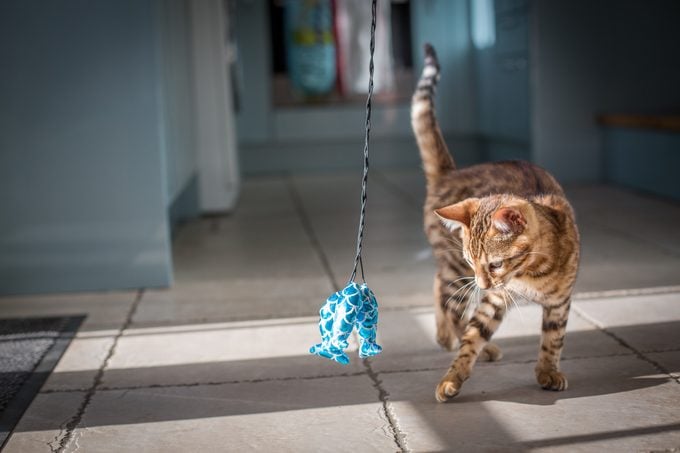
A cat that’s excited will often have similar body language to a relaxed cat, but with a few variations. A good way to tell the difference is by noting the cat-tail language. “You may notice the cat holding its tail up, with the tip quivering,” says Nigbur-Mays. “As a cat becomes more aroused, you may see its tail held lower and/or see the tail start to flick or swish back and forth.”
Additionally, your cat’s eyes may widen and its pupils may dilate, and its ears may shift forward or swivel back toward its head. When your cat is really excited or going ham on its favorite toy, you may even see its fur start to stand up on end.
Often when your cat exhibits this behavior, it’s a sign that it wants to play or is enjoying the playtime you’re spending together. If it starts to feel and look more tense, this cat body language could mean your cat is overstimulated or starting to feel agitated.
“It’s important to note that cat body language exists on a spectrum, and some cats will exhibit body language that communicates multiple feelings at the same time,” says Nigbur-Mays. “Therefore, it’s helpful to consider the entire context the cat is in, in addition to its body language and behavior, when you are trying to decipher what a cat is communicating.”
Telltale signs of an excited or playful cat
- Eyes: Widened with dilated pupils
- Ears: Shifted forward or reversed
- Whiskers: Forward and fanned out
- Body: Loose and relaxed
- Tail: Upright and possibly quivering at the tip; held lower and slowly swishing
Angry, fearful, or anxious
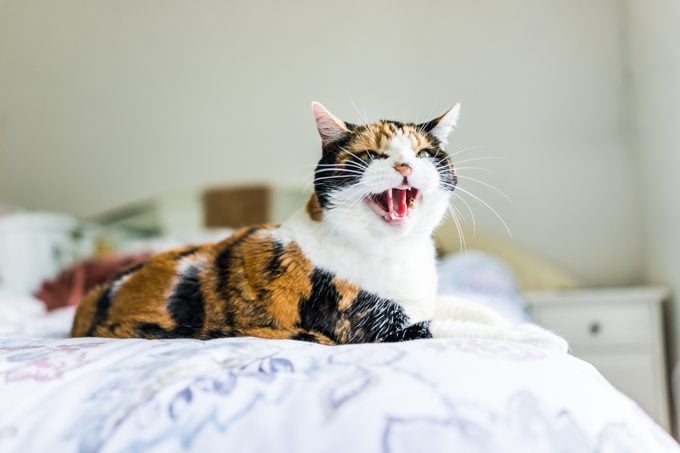
A cat that’s feeling scared, anxious, stressed, or agitated will often display bodily responses that tell you or other animals it’s time to back up. This includes hissing, trembling or shaking, and guttural meowing. In severe cases, the cat may also lose control of its bladder or bowels.
“A stressed or fearful cat will also attempt to change its perceived size,” says Wolffberg. “This could manifest by a cat making itself appear bigger by arching its back, making its fur stand up, erecting its tail and ears, and standing sideways.”
However, some cats display the exact opposite cat body language when they’re anxious or scared, notes Wolffberg. They may crouch up into a tight ball with their limbs and tail tucked away. This enables the cat to escape if a strong threat arises.
Telltale signs of an angry, fearful, or anxious cat
- Eyes: Wide and dilated
- Ears: Flattened
- Whiskers: Flattened against their face
- Body: Arched and tense with erected fur; tightly bound with limbs tucked
- Tail: Puffed up and/or quick swishing; tucked under their body
Now that you have a better understanding, read on to find out why cats chirp, love boxes, and sleep so much.
Sources:
- Sam Nigbur-Mays, behavioral sciences team counselor at ASPCA
- Doron Wolffberg, founder of All About Cats

